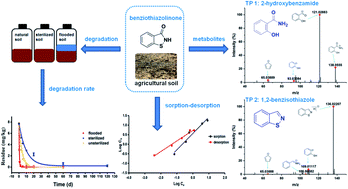Dissipation and sorption–desorption of benzisothiazolinone in agricultural soils and identification of its metabolites†
Abstract
Benzisothiazolinone has been widely used to control bacterial and fungal diseases in various agricultural crops by destroying the nuclear structure and interfering with the metabolism of microbial cells. In this study, the dissipation, transformation and sorption–desorption of benzisothiazolinone (BIT) in five soils were investigated to evaluate its environmental fate. Results showed that the degradation of BIT in all the tested soils fitted the first order kinetics and increased with soil organic matter (OM) content. Degradation differences between unsterilized natural and sterilized soils (t1/2 = 0.09–26.66 and 6.80–86.64 d) suggested that BIT degradation is primarily driven by biological processes and assisted by abiotic degradation. Additionally, BIT dissipated fastest in flooded soils (t1/2 = 0.20–4.53 d), indicating that anaerobic microorganisms are more likely to degrade BIT compared to aerobic microbes. Also, during the soil degradation process, two metabolites were monitored and identified for the first time. BIT sorption was a spontaneous physical process with no desorption hysteresis effect, which fit the Freundlich model. BIT causes relatively strong sorption (log KOC = 3.76–4.19) and low persistence in soils, thus exhibiting a low potential risk for groundwater contamination.



 Please wait while we load your content...
Please wait while we load your content...